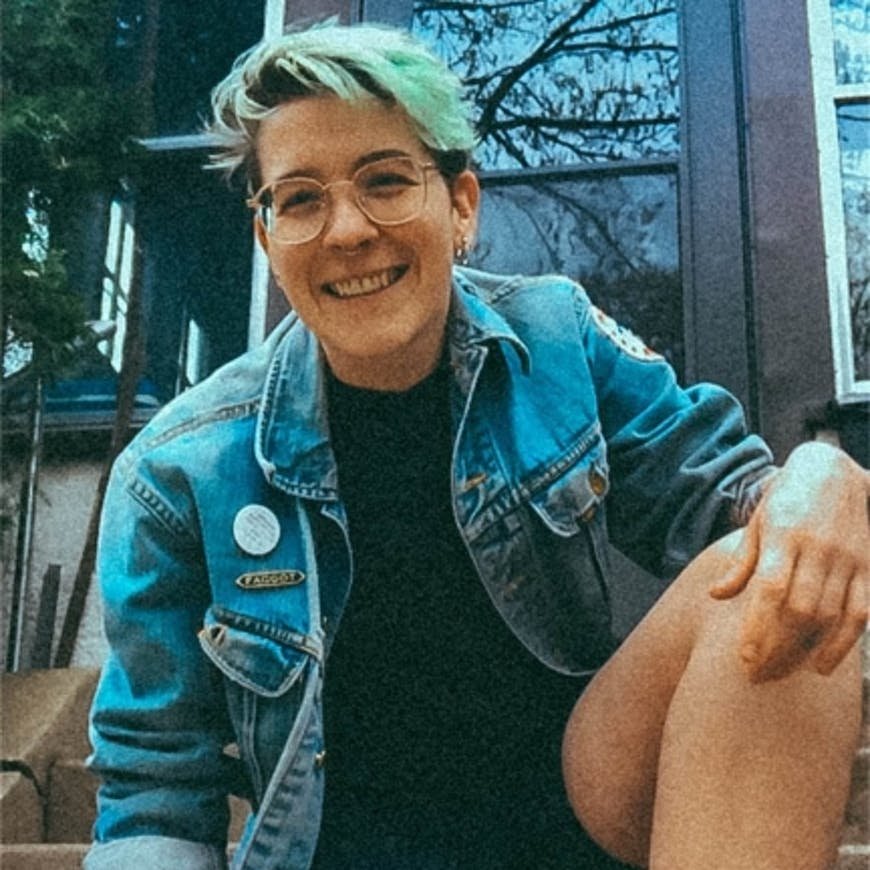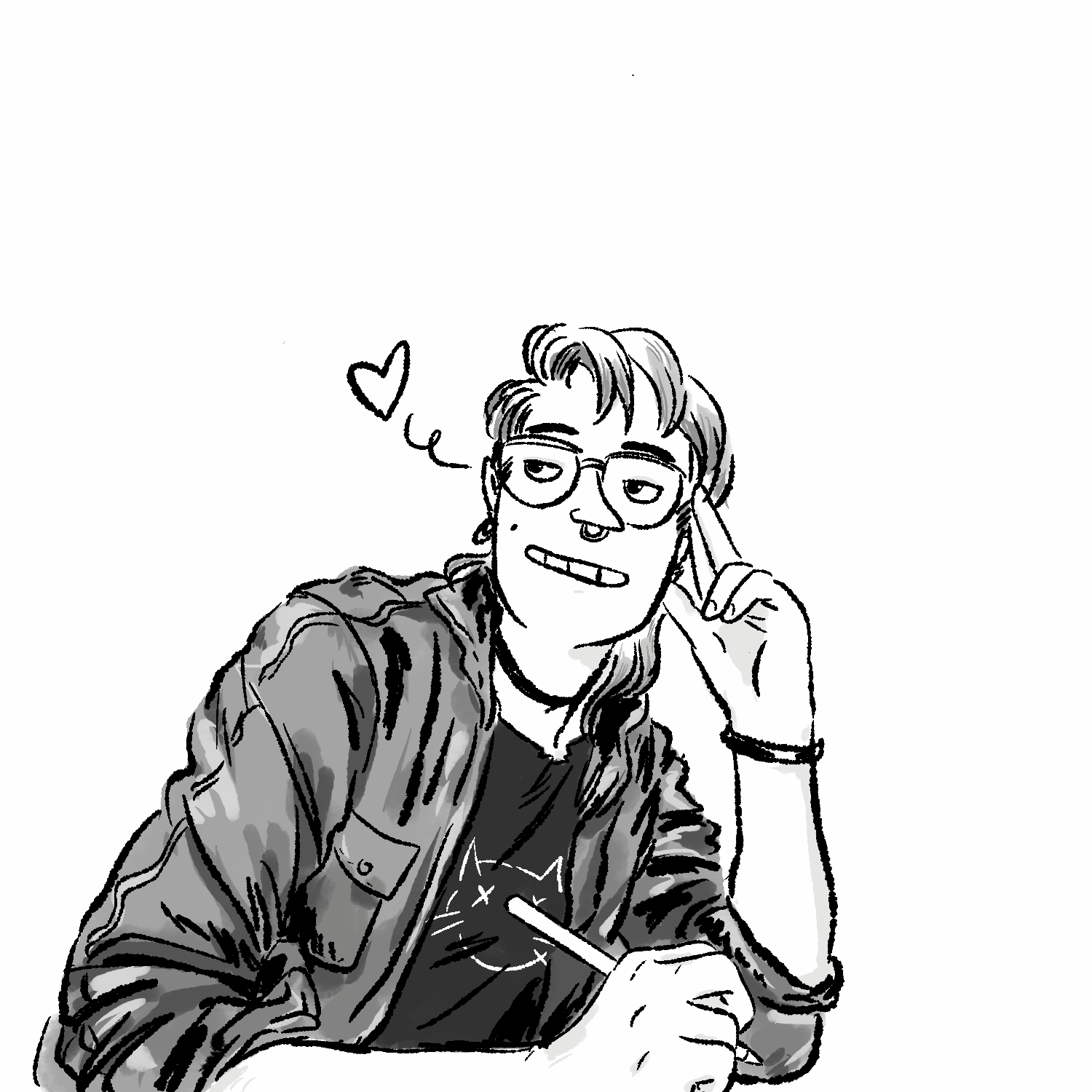“Pour orange juice into a flute glass and gently pour the sparkling wine. Stir gently.”
-International Bartenders Association
Mimosa, the new queer graphic novel from Archie Bongiovanni opens with middle aged queer people lamenting the state of their careers and sex lives and let me tell you I feel seen. Over the titular libation, we meet the four members of this chosen family: There’s Jo who teaches music at a rock camp for trans youth; the buttoned up nonprofit worker Elise pining to make sexy bad decisions with her boss; the hedonistic painter Alex who loves his friends but lives for the next big party; and nonbinary parent, punk, and blogger Chris struggling with single parenthood after their dream marriage ended in bitter divorce. Over this, one of many such brunches this chosen family has had, an idea is generated: a queer dance party for queer people over thirty.
Called Grind, the party sets these four friends on a collision course with each other and with themselves that will put all of their relationships to trial. Beyond here, we approach too much than I care to spoil; it is safe to say that everyone makes some very bad decisions and behaves badly—and yet, you still want things to be better for all of them. They’re all real people you’ve seen in my life and have been in your life; and one of the joys in rereading it is getting to look at each of these people as protagonists and antagonists. It’s a remarkably exercise in empathy.
But then, the whole book is remarkable. Bongiovanni has produced a marvelously crafted graphic novel. The characters are complex and multifaceted, the pacing masterfully controlled and used to powerful effect. As someone who’s enjoyed their work since the photocopied zine edition of their guide to they/them pronouns, it’s astonishing to see just how considered every aspect of this book is—right down to the brunch food themed endpapers. In fact, around my sixth or seventh read-through of the book I realized that even the title is incredibly well-considered; for all of its impact in the story, it could have readily been called Grind, but it’s not and that’s a huge clue to what this book is really about. Mimosa is an amazing examination of queer lives and chosen family in all its messy fabulous glory.
I'm curious about how this story came together as a graphic novel. Like your webcomic Grease Bats it's about queer community, but it's such a different approach. What was it like when Mimosa fixed in your head-- when you knew what the story was about and that a standalone graphic novel was the way to tell it?
I knew that after Grease Bats I was going to put my time and effort into telling a longer-form story. I didn’t want to be limited to panels or page counts and wanted to write something where the characters and settings had time to breathe. A standalone graphic novel was going to be my next endeavor, no matter what it was about, it just happened that the idea of Mimosa and the characters in the comic happened at the same time I had the ability to create and pitch a longer graphic novel.
You have a lot of crowd scenes in here that you had to draw, and cleverly you set most of them at a party full of beautiful sexy queer people; well played. But some of the visuals that struck me the hardest were the panels devoid of people. (The overpass on page 181 lingered with me in particular.) What were the biggest challenges for you as an artist and what impressed you the most with what you've accomplished?
Backgrounds are always hard for me! I wish I could enthusiastically get into them, but it’s a challenge every time. I need a lot of reference photos and it’s hard to me to come up with the layout of a room or building on my own. Most of the settings in Mimosa are real places I either live in or visit often and I am really proud of the way they turned out. I tried to include a lot of easter eggs in my backgrounds (see how many fisting references I tossed in lol) which makes drawing them more delightful. I am really proud of the party scenes, I really wanted to capture that essence of being surrounded by queer hotties with music pumping. I think those scenes were particularly meaningful (and hard) because I was drawing it during 2020. I was aching to be in a sweaty basement where I could reach out and touch a glittery sweaty homosexual and since I wasn’t able to do it, I tried to draw it.
Grease Bats was originally published as a webcomic on Autostraddle, and Mimosa was shared in progress on your Patreon account. One of the things about doing comics on the internet is that the feedback can be immediate. How does that kind of community dialogue affect you as an artist?
My art was never meant to exist in a void. Whatever I draw, I want to share it and for it to be seen. I’m an exhibitionist in many different ways! I don’t really care what comes back at me when I show my stuff, but I am constantly drawn to share myself/my work. I think this is why zines have been so important to me. I don’t need to wait for anyone’s approval before putting something out in the world. It’s really encouraging and helpful to share my work on Patreon. Even though I want to show off my stuff, the actual creation of comics is fairly lonely, so having a spot to showcase work-in-progress was vital.
The characters in Mimosa all feel very real to me. Part of this is that I'm a queer person in my forties, but a larger part is the physicality you give these characters. Comics are a static medium but you convey a sense of body language for all of them. I feel you could reduce your cast down to stick figures and I could still identify whether I'm looking at Alex or Elise just by how they move around in a scene. How do you go about creating your character's physical presence?
Such a fun question! A lot of it comes down to thumbnailing. When working on my page layout, I also, with literal stick figures, draw how my characters stand, move and react. Working small and simplistic helps emphasize a character’s body language. If I can tell in that simple drawing how a character is feeling, then I know I’ve done it right. Also, I work alone in my studio, so I frequently say out loud what a character is saying or reacting to and see what my own body does while envisioning that character. It’s actually one of my favorite parts of the comic making process! You just act it out a little! (Alone in your studio where no one can see lol)
In an interview about his erotic writing, Patrick Califia said that part of what he was doing with his stories of queer kink was performing a kind of journalism, creating a document of his community in fiction. Elsewhere Alison Bechdel described her characters in Dykes to Watch Out For as a form of wish-fulfillment: she told stories about people she wanted to be friends with in real life. What balance of realism and idealism do you find drawn to in your own fictional work?
These characters are all fictionalized but they’re a conglomerate of a million things. People I know, myself, stories I’ve heard, things I witnessed, etc. My characters aren’t ideal characters. There’s a few of them I wouldn’t really want to be friends with! They’re faulty and selfish and make mistakes and in that way perhaps it’s more of a document of my community like Califia said. We’re fucking messy, and that’s okay, and we shouldn’t pretend otherwise to have our stories shown.
About Archie Bongiovanni
Archie Bongiovanni is a cartoonist and illustrator living in Minneapolis. They are the creator of numerous zines and the webcomic Grease Bats; and co-creator of the nonfiction graphic novels The Stonewall Riots: Making a Stand for LGBTQ Rights with A. Andrews, and A Quick and Easy Guide to They/Them Pronouns with Tristan Jimerson. Bongiovanni is a 2020 Tin House Summer Workshop Alumni, a 2019 Next Step Fund awardee, a Jerome Hill Fellowship Finalist and a Minnesota State Arts Board Creative Support Grant awardee in 2020.
About Greg Baldino
A down-beat Don Quixote of the Midwest, Greg Baldino is a prolific journalist and essayist, and the author and co-editor of 5 books, including the acclaimed Early History of the Gay Rights Movement and the banned Everything You Need to Know About Bisexuality. He can usually be found somewhere in the Midwest, probably drinking coffee.











